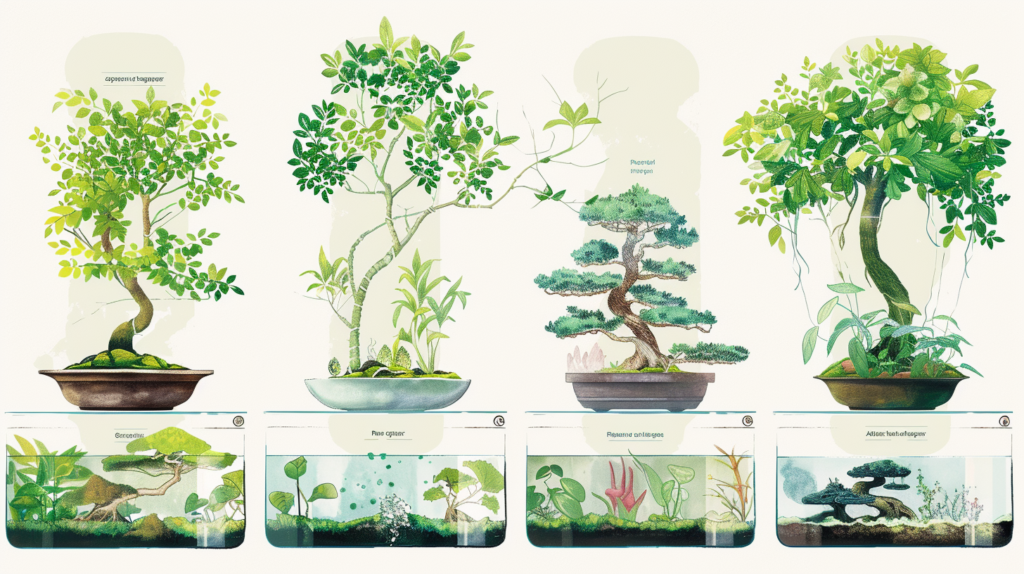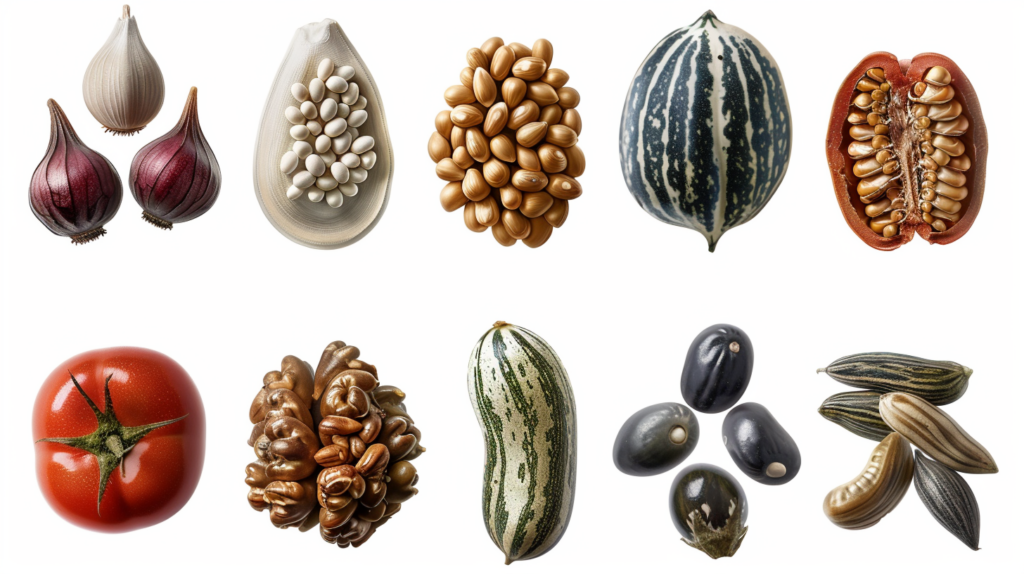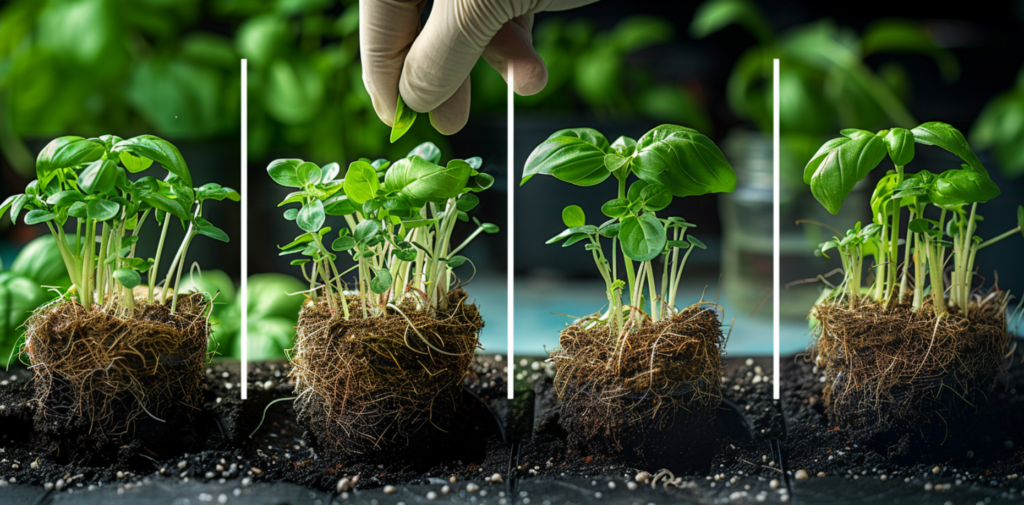Introduction
Bonsai tree hydroponics, a captivating fusion of ancient art and modern technology, has been gaining immense popularity among plant enthusiasts worldwide. This innovative approach allows you to cultivate miniature trees in a soil-less environment, providing precise control over their growth and development. By embracing hydroponics, you unlock a world of benefits, including efficient nutrient delivery, water conservation, and the ability to grow bonsai trees in virtually any indoor or outdoor space. As I embark on this journey, I invite you to explore the fascinating realm of bonsai tree hydroponics, where the beauty of nature meets the ingenuity of human innovation.
Overview of bonsai tree hydroponics and its growing popularity
Bonsai tree hydroponics has emerged as a captivating trend, capturing the hearts of plant lovers and horticultural enthusiasts alike. This innovative approach combines the ancient art of bonsai cultivation with the cutting-edge technology of hydroponics, allowing growers to nurture miniature trees in a controlled, soil-less environment.
The popularity of bonsai tree hydroponics has skyrocketed in recent years, driven by its numerous advantages and the growing interest in sustainable gardening practices. By eliminating the need for soil, hydroponic systems offer a clean, efficient, and space-saving solution for cultivating bonsai trees indoors or in urban settings.
Additionally, the precise control over nutrient delivery and water management ensures optimal growth conditions, resulting in healthier and more vibrant bonsai specimens. As awareness of environmental conservation increases, the water-saving and resource-efficient nature of hydroponics has further fueled its appeal. Growers can minimize water wastage while providing their bonsai trees with the exact nutrients they require, fostering a harmonious balance between art and sustainability. Moreover, the versatility of hydroponic systems has opened up new possibilities for bonsai enthusiasts, allowing them to experiment with various growing techniques and create unique displays that seamlessly blend traditional bonsai aesthetics with modern design elements. This fusion of ancient tradition and contemporary innovation has captivated a diverse audience, from seasoned bonsai masters to urban gardeners seeking a rewarding and space-efficient hobby.
Benefits of growing bonsai trees hydroponically
Growing bonsai trees hydroponically offers a myriad of benefits that have contributed to its rising popularity. One of the most significant advantages is the efficient use of resources. Hydroponic systems require significantly less water than traditional soil-based cultivation, making them an environmentally friendly choice, especially in areas with limited water resources. Another notable benefit is the precise control over nutrient delivery. In a hydroponic setup, the nutrient solution can be carefully tailored to meet the specific needs of bonsai trees, ensuring optimal growth and vigor. This level of control is challenging to achieve in soil-based systems, where nutrient availability can fluctuate.
Hydroponic bonsai cultivation also allows for greater flexibility in terms of growing spaces. Since soil is not required, bonsai trees can be grown in virtually any indoor or outdoor location, making it an ideal choice for urban gardeners or those with limited outdoor space. This versatility has opened up new possibilities for creative displays and artistic expressions. Furthermore, hydroponic systems are generally easier to maintain and less susceptible to soil-borne pests and diseases. The sterile growing environment minimizes the risk of infestations, reducing the need for harsh chemical treatments and promoting a more sustainable approach to bonsai cultivation.
Lastly, the rapid growth rate of bonsai trees in hydroponic systems is a significant advantage. With optimal nutrient delivery and growing conditions, bonsai trees can develop faster, allowing enthusiasts to achieve desired shapes and styles in a shorter timeframe, making the art of bonsai more accessible and rewarding.
Step 1: Choosing the Right Bonsai Tree Species
When embarking on the journey of bonsai tree hydroponics, selecting the right species is crucial. Certain varieties are better suited for hydroponic cultivation than others, thriving in the controlled environment and responding well to the unique growing conditions. Factors such as growth habits, root systems, and nutrient requirements should be carefully considered to ensure a successful and rewarding experience.
Suitable bonsai tree varieties for hydroponic cultivation
Several bonsai tree varieties have proven to be well-suited for hydroponic cultivation, thanks to their adaptability and resilience.
One of the most popular choices is the Chinese Elm (Ulmus parvifolia), renowned for its graceful appearance and ease of maintenance. This species readily adapts to hydroponic systems, producing abundant foliage and responding favorably to pruning and shaping techniques.
Another excellent option is the Ficus species, particularly the Ficus Benjamina (Weeping Fig) and Ficus Retusa (Taiwanese Ficus). These trees are known for their ability to thrive in various growing conditions, making them ideal candidates for hydroponic setups.
Their aerial root systems and tolerance for pruning make them highly versatile for bonsai enthusiasts. The Japanese Maple (Acer palmatum) is a stunning choice for hydroponic bonsai cultivation, offering a wide range of vibrant foliage colors and delicate branching patterns. While slightly more demanding in terms of nutrient requirements, these maples can flourish in well-maintained hydroponic systems, rewarding growers with their exquisite beauty. For those seeking a tropical flair, the Banyan Fig (Ficus Benghalensis) and the Hawaiian Umbrella Tree (Brassaia actinophylla) are excellent choices.
These species adapt well to hydroponic environments and can create impressive bonsai specimens with their unique growth habits and aerial root systems. It’s important to note that while many bonsai tree varieties can be grown hydroponically, some species may require more specialized care and attention. Consulting with experienced bonsai enthusiasts or horticulturists can help determine the most suitable options based on individual preferences, skill levels, and growing conditions.
Factors to consider when selecting a species
When selecting a bonsai tree species for hydroponic cultivation, several factors must be taken into consideration to ensure successful growth and development.
One crucial aspect is the tree’s natural growth rate. Some species, such as the Chinese Elm or Ficus, have a relatively fast growth rate, making them ideal for those seeking quicker results or frequent pruning and shaping sessions. Conversely, slower-growing varieties like the Japanese Maple may require more patience but offer a unique aesthetic appeal.
Another important factor is the tree’s root system. Species with fibrous root systems, such as the Ficus or Banyan Fig, tend to adapt well to hydroponic environments, as their roots can effectively absorb nutrients from the nutrient solution. Trees with tap root systems may require additional care and specialized hydroponic setups.
The tree’s tolerance to pruning and shaping is also a consideration, as bonsai cultivation involves regular maintenance to achieve desired forms and styles. Species like the Chinese Elm and Ficus are known for their resilience and ability to bounce back from aggressive pruning, making them suitable for beginners or those seeking more intricate bonsai designs.
Finally, the tree’s specific nutrient requirements should be evaluated. Some species may have higher demands for certain nutrients, necessitating careful monitoring and adjustment of the nutrient solution. Consulting with experienced bonsai growers or horticulturists can provide valuable insights into the specific needs of different species and help ensure their optimal growth in a hydroponic environment.
Step 2: Setting Up the Hydroponic System
Establishing a suitable hydroponic system is a crucial step in cultivating bonsai trees successfully. Various types of systems are available, each with its own set of components and requirements. Careful planning and assembly are essential to create an optimal growing environment tailored to the specific needs of your chosen bonsai species.
Types of hydroponic systems for bonsai trees
When it comes to hydroponic systems for bonsai trees, growers have several options to choose from, each with its own unique advantages and considerations. One popular choice is the ebb and flow system, also known as the flood and drain system.
This setup involves periodically flooding the growing tray with nutrient solution, allowing the roots to absorb the necessary nutrients before draining the excess solution back into the reservoir. This system is well-suited for bonsai trees as it mimics the natural ebb and flow of water, promoting healthy root development. Another viable option is the drip system, which involves a network of tubing and emitters that deliver a steady stream of nutrient solution directly to the root zone of each bonsai tree.
This system offers precise control over nutrient delivery and can be easily automated, making it a convenient choice for those with multiple bonsai specimens or limited time for manual watering. For those seeking a more traditional approach, the deep water culture (DWC) system may be appealing.
In this setup, the bonsai tree’s roots are suspended in a nutrient-rich solution, with an air stone providing oxygenation.

This system is known for its simplicity and effectiveness, although it may require more frequent monitoring and adjustments to maintain optimal nutrient levels and water quality. Aeroponic systems, which involve suspending the roots in an enclosed chamber and periodically misting them with a nutrient solution, are also gaining popularity among bonsai enthusiasts. These systems offer excellent oxygenation and nutrient uptake but may require more specialized equipment and maintenance.
Ultimately, the choice of hydroponic system will depend on factors such as the bonsai species, the grower’s experience level, and personal preferences. It’s essential to research and understand the pros and cons of each system before making a decision, as well as to consider the specific requirements of the bonsai trees being cultivated.
Essential components and equipment needed
To set up a successful hydroponic system for bonsai trees, several essential components and equipment are required. At the core of any hydroponic setup is the growing container or reservoir, which holds the nutrient solution.
These containers can be made from various materials, such as plastic, ceramic, or even recycled containers, as long as they are food-safe and opaque to prevent algae growth. An air pump and air stone are crucial for providing adequate oxygenation to the nutrient solution, ensuring healthy root development and preventing stagnation. Additionally, a submersible pump or drip system is necessary for circulating and delivering the nutrient solution to the bonsai trees. Grow lights are often essential for indoor hydroponic setups, as they provide the necessary light intensity and spectrum for optimal plant growth. LED grow lights are popular choices due to their energy efficiency and customizable light spectra.
Monitoring and adjusting the pH and nutrient levels of the solution is vital for maintaining a healthy growing environment. pH meters, TDS (Total Dissolved Solids) meters, and nutrient test kits are invaluable tools for this purpose. Other essential equipment includes net pots or growing baskets to hold the bonsai trees, an air stone diffuser, tubing for the drip system (if applicable), and a timer for automating the nutrient delivery and lighting cycles. Lastly, high-quality hydroponic nutrients specifically formulated for bonsai trees or other woody plants are crucial for providing the necessary macro and micronutrients for optimal growth and development.
Step-by-step guide to assembling the system
Assembling a hydroponic system for bonsai trees can seem daunting at first, but with a step-by-step approach, it becomes a straightforward process. First, choose the appropriate growing container or reservoir based on the size and number of bonsai trees you plan to cultivate. Ensure the container is opaque to prevent algae growth and has adequate drainage holes.
Next, install the air pump and air stone, positioning the air stone at the bottom of the reservoir to provide optimal oxygenation to the nutrient solution. Connect the air pump to the air stone using airline tubing, ensuring a secure and airtight connection. If using a drip system, set up the submersible pump and tubing network, positioning the emitters or drip rings around the base of each bonsai tree.
Alternatively, for an ebb and flow system, install the flood tray and drainage system, ensuring proper water flow and drainage. Once the basic system is in place, prepare the growing medium or net pots for your bonsai trees. Use a well-draining, inert medium like expanded clay pebbles or hydroton to anchor the roots and allow for proper aeration and nutrient uptake.
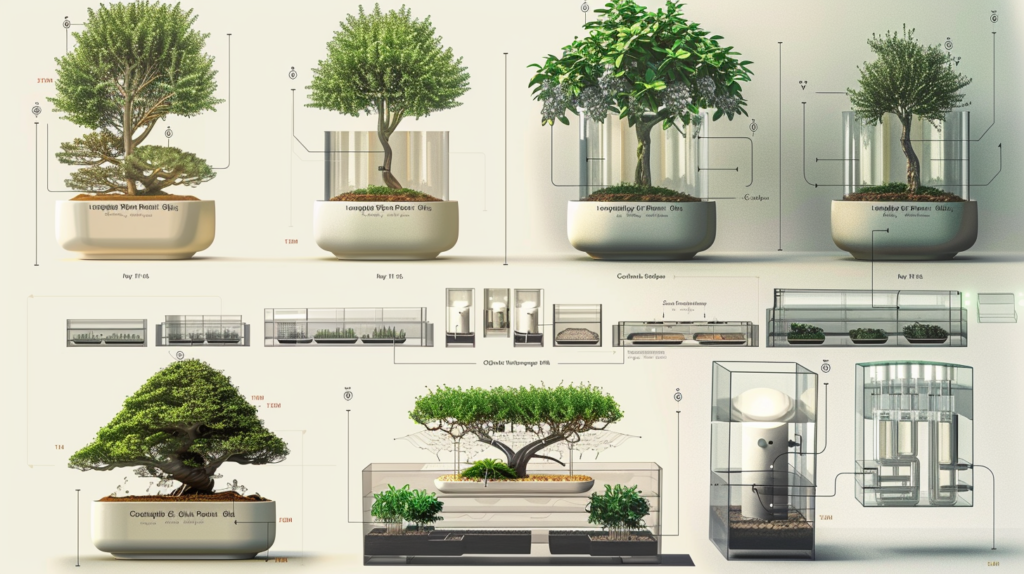
Carefully transplant your bonsai trees into the prepared growing medium, taking care not to damage the delicate root systems. Position the trees in the system, ensuring they receive adequate light exposure and nutrient distribution. Mix the hydroponic nutrient solution according to the manufacturer’s instructions, paying close attention to the recommended ratios and concentrations for your specific bonsai species. Adjust the pH level to the optimal range, typically between 5.5 and 6.5, using pH adjusters if necessary.
Fill the reservoir with the prepared nutrient solution, ensuring the roots are fully submerged or receiving adequate moisture, depending on your chosen system type. If using grow lights, position them at the recommended distance and height above the bonsai trees, ensuring even light distribution and adjusting the intensity and duration as needed. Finally, set up any timers or automation systems to regulate nutrient delivery, lighting cycles, and other essential functions. This will help maintain a consistent and optimal growing environment for your bonsai trees. Remember to monitor and adjust nutrient levels, pH, and other parameters regularly, as well as perform routine maintenance tasks like pruning and shaping to keep your bonsai trees thriving in their hydroponic environment.
Step 3: Preparing the Growing Environment
Cultivating bonsai trees hydroponically requires meticulous attention to the growing environment. Factors such as lighting, temperature, and humidity play crucial roles in ensuring the health and vigor of your miniature trees. Implementing techniques to maintain optimal conditions is essential for achieving successful growth and development.
Importance of lighting, temperature, and humidity
Proper lighting, temperature, and humidity are vital components of a successful hydroponic bonsai growing environment. Lighting is crucial for photosynthesis and overall plant health.
Bonsai trees require adequate light intensity and duration, typically between 6 to 8 hours of direct sunlight or equivalent artificial lighting per day. LED grow lights are often used in indoor setups, providing the necessary light spectrum for optimal growth. Temperature plays a significant role in regulating plant metabolism and growth rates. Most bonsai species thrive in temperatures ranging from 65°F to 75°F (18°C to 24°C) during the day and slightly cooler at night. Extreme temperatures can stress the plants and hinder their development. Humidity is another critical factor, as bonsai trees are susceptible to desiccation and leaf browning in dry environments. Maintaining a relative humidity level between 50% and 70% is generally recommended.
Humidity can be increased by using humidifiers, pebble trays, or misting systems, depending on the specific setup and growing conditions. Achieving the right balance of these environmental factors is crucial for promoting healthy growth, preventing stress, and encouraging the desired aesthetic characteristics of bonsai trees. Monitoring and adjusting these parameters as needed will ensure your hydroponic bonsai specimens thrive and reach their full potential.
Techniques for maintaining optimal growing conditions
Maintaining optimal growing conditions in a hydroponic bonsai setup requires a combination of techniques and careful monitoring. One effective approach is to invest in high-quality grow lights that can provide the appropriate light intensity and spectrum for your bonsai species. LED grow lights are an excellent choice as they are energy-efficient and can be adjusted to mimic different light conditions.
Temperature control is another crucial aspect. Depending on your setup, you may need to incorporate heating or cooling systems to maintain the ideal temperature range. Small space heaters or air conditioning units can be used, or you can explore more specialized options like water chillers or heat exchangers for larger hydroponic systems. Humidity levels can be managed through various methods, such as using humidifiers, pebble trays, or misting systems.
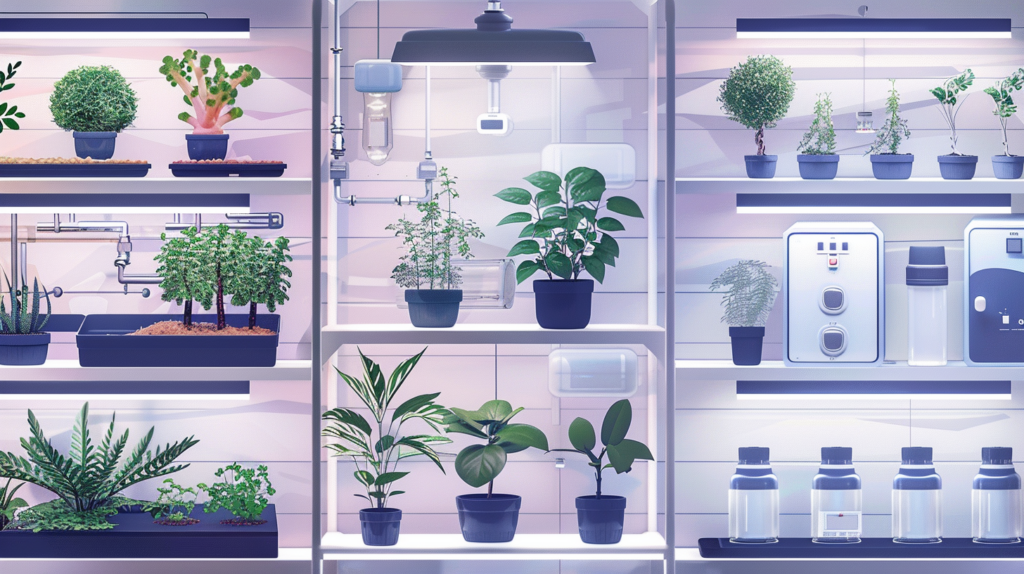
Pebble trays, which are shallow containers filled with water and pebbles, can increase humidity levels through evaporation. Misting systems, on the other hand, periodically release a fine mist of water into the growing area, effectively raising humidity levels. Proper air circulation is also essential for preventing stagnant air pockets and promoting healthy plant growth. Strategically placed fans or air pumps can help circulate the air and ensure even distribution of temperature, humidity, and carbon dioxide levels throughout the growing area.
Regular monitoring and adjustments are key to maintaining optimal conditions. Invest in reliable monitoring equipment, such as thermometers, hygrometers, and light meters, to track environmental parameters accurately. Be prepared to make adjustments as needed, whether it’s adjusting light intensity, tweaking temperature settings, or modifying humidity levels.
By implementing these techniques and staying vigilant in monitoring and adjusting the growing environment, you can create the ideal conditions for your hydroponic bonsai trees to thrive and showcase their beauty to the fullest.
Step 4: Nutrient Management and Maintenance
Proper nutrient management and regular maintenance are crucial for ensuring the health and longevity of your hydroponic bonsai trees. Understanding their specific nutrient requirements, selecting and mixing appropriate hydroponic nutrients, and implementing effective pruning and training techniques are essential steps in this process.
Understanding the nutrient requirements of bonsai trees
Bonsai trees, like all plants, require a balanced supply of essential nutrients to thrive and maintain their miniature stature. Understanding their specific nutrient requirements is crucial for successful hydroponic cultivation. Macronutrients such as nitrogen, phosphorus, and potassium are vital for overall growth, root development, and flowering.
Micronutrients like iron, manganese, and boron play essential roles in various physiological processes, including photosynthesis and enzyme activation. It’s important to note that bonsai trees have unique nutrient needs compared to their full-sized counterparts. Due to their restricted root systems and compact size, they may require higher concentrations of certain nutrients to support their growth and development.
Additionally, different species and growth stages may have varying nutrient demands, necessitating adjustments to the nutrient solution. Monitoring nutrient levels and making timely adjustments is crucial to prevent deficiencies or excesses, which can lead to stunted growth, discoloration, or other health issues. Regular testing of the nutrient solution using specialized meters or test kits can help ensure optimal nutrient balance and guide any necessary adjustments or supplementation.
By understanding the specific nutrient requirements of your bonsai trees and providing a tailored nutrient solution, you can promote vigorous growth, vibrant foliage, and overall plant health in your hydroponic setup.
Selecting and mixing hydroponic nutrients
Selecting and mixing the appropriate hydroponic nutrients is a critical step in ensuring the success of your bonsai tree cultivation. There are various nutrient formulations available in the market, each designed to cater to specific plant types and growth stages. When choosing nutrients for your bonsai trees, it’s essential to opt for high-quality, balanced formulations specifically tailored for woody plants or bonsai species. Many reputable hydroponic nutrient brands offer specialized bonsai nutrient blends that contain the optimal ratios of macronutrients (nitrogen, phosphorus, and potassium) and essential micronutrients like iron, calcium, and magnesium.
These blends are formulated to support the unique growth patterns and nutrient demands of miniature trees. When mixing the nutrient solution, it’s crucial to follow the manufacturer’s instructions carefully, as improper dilution or concentration can lead to nutrient deficiencies or toxicities, both of which can be detrimental to your bonsai trees’ health.
Measuring tools like graduated cylinders or digital scales can help ensure accurate measurements and consistent nutrient concentrations. It’s also important to consider the pH level of the nutrient solution, as it affects the availability and uptake of nutrients by the plants. Most bonsai species thrive in a slightly acidic pH range of 5.5 to 6.5. pH adjusters or buffers may be necessary to maintain the optimal pH level for your specific nutrient blend and water source.
Monitoring and adjusting nutrient levels
Monitoring and adjusting nutrient levels is a crucial aspect of successful hydroponic bonsai cultivation. Regular testing of the nutrient solution using specialized meters or test kits is essential to ensure optimal nutrient balance. Parameters such as electrical conductivity (EC) and pH should be closely monitored and adjusted as needed.
If nutrient levels are too low, supplementation with additional nutrients may be required. Conversely, if levels are too high, diluting the solution or performing a complete nutrient solution change may be necessary to prevent nutrient toxicity. It’s also important to consider the growth stage of your bonsai trees when adjusting nutrient levels.
During periods of active growth, higher nutrient concentrations may be required, while during dormancy or resting phases, lower levels may be more appropriate. By consistently monitoring and making timely adjustments to the nutrient solution, you can provide your bonsai trees with the optimal nutrient balance, promoting vigorous growth, vibrant foliage, and overall plant health.
Pruning and training techniques for bonsai trees
Pruning and training techniques are essential for shaping and maintaining the desired aesthetic form of bonsai trees. Regular pruning helps control the size and shape of the tree, promoting dense foliage and intricate branching patterns. When pruning, it’s crucial to use clean, sharp tools to make precise cuts and avoid damaging the delicate branches.
Wiring is a common training technique used to guide and position branches into desired shapes. Carefully wrapping the branches with specialized bonsai wire allows you to create intricate designs and styles, such as cascading or semi-cascade forms. It’s important to monitor the wires regularly and adjust or remove them as needed to prevent scarring or constriction. Defoliation, the selective removal of leaves, is another technique used to encourage new growth and promote ramification (branching).
This process should be done gradually and with care, as excessive defoliation can stress the tree. Repotting is also a crucial aspect of bonsai maintenance, typically done every two to three years. This process involves carefully removing the tree from its current container, pruning the roots, and replanting it in fresh soil or growing medium.
Repotting helps maintain the tree’s compact size and promotes healthy root growth. By mastering these pruning and training techniques, you can create stunning bonsai specimens that showcase the art of miniaturization and the beauty of nature in a compact form.
Step 5: Troubleshooting and Best Practices
Mastering bonsai tree hydroponics requires a keen eye for troubleshooting potential issues and implementing best practices. By identifying and addressing common problems promptly and following proven techniques, you can ensure the long-term health and vitality of your miniature trees.
Common issues and their solutions
Cultivating bonsai trees hydroponically can present various challenges, but being aware of common issues and their solutions can help you navigate these obstacles effectively.
One frequent problem is nutrient deficiencies or toxicities, which can manifest as discolored leaves, stunted growth, or overall poor plant health. Regular monitoring and adjusting of nutrient levels, as well as maintaining the proper pH range, can help prevent and address these issues. Another common concern is root rot or other fungal infections, which can be caused by stagnant water or poor oxygenation.
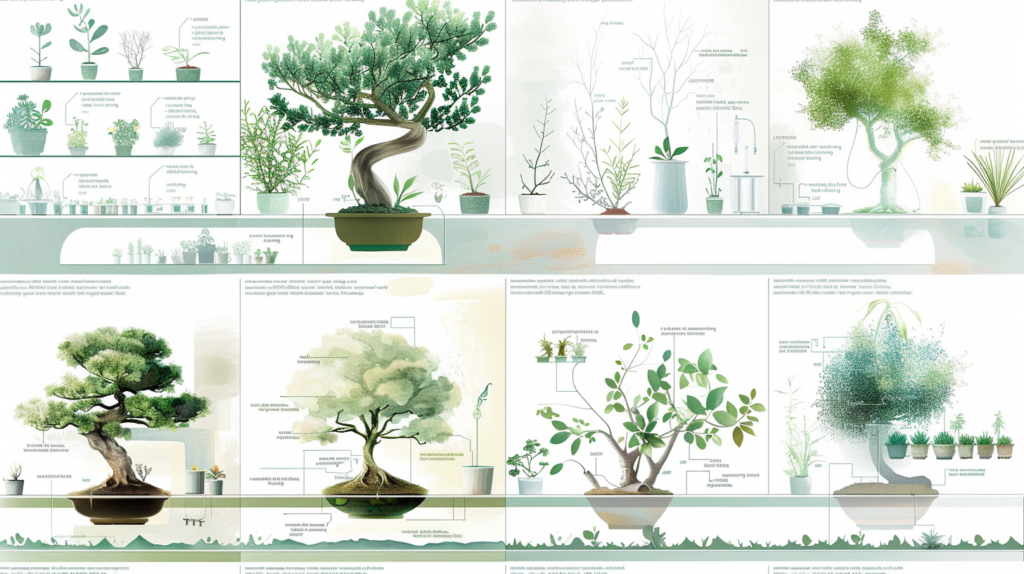
Ensuring proper air circulation, using an air stone, and maintaining clean growing conditions can help mitigate these problems. If root rot does occur, promptly removing affected roots and treating with a suitable fungicide may be necessary. Pests, such as spider mites or mealybugs, can also be a nuisance in hydroponic bonsai setups. Implementing integrated pest management strategies, such as introducing beneficial insects or using organic pesticides, can help control infestations without compromising the health of your trees. Algae growth in the nutrient solution is another common issue, particularly in systems with excessive light exposure.
Maintaining proper light levels, using opaque containers, and regularly cleaning the system can help prevent algae buildup. Additionally, environmental factors like temperature fluctuations or improper humidity levels can stress bonsai trees and hinder their growth. Investing in reliable monitoring equipment and implementing techniques to maintain optimal growing conditions can help mitigate these challenges. By staying vigilant and addressing issues promptly, you can ensure the long-term success of your hydroponic bonsai cultivation endeavors.
Tips for successful bonsai tree hydroponics
To achieve success in bonsai tree hydroponics, it’s essential to follow a few key tips and best practices. First and foremost, start with healthy, disease-free specimens from reputable sources. Selecting the right species suited for hydroponic cultivation is crucial, as different varieties have varying requirements and tolerances.
Maintain a consistent and diligent maintenance routine, including regular monitoring of nutrient levels, pH, temperature, and humidity. Promptly address any issues or imbalances to prevent further complications and ensure optimal growing conditions.
Invest in high-quality equipment and materials, such as reliable grow lights, air pumps, and nutrient solutions specifically formulated for bonsai trees or woody plants. Cutting corners on essential components can compromise the health and longevity of your miniature trees. Patience and attention to detail are vital when it comes to pruning, wiring, and shaping your bonsai specimens. Take the time to master these techniques and follow the guidance of experienced bonsai enthusiasts or professionals.
Finally, embrace the learning process and don’t be discouraged by setbacks. Bonsai tree hydroponics is a rewarding hobby that requires dedication and continuous learning. Experiment with different techniques, document your observations, and share your experiences with the bonsai community to further your knowledge and skills.
Integrating hydroponics with traditional bonsai practices
Integrating hydroponic cultivation with traditional bonsai practices can create a harmonious blend of modern technology and ancient artistry. While hydroponics offers precise control over nutrient delivery and growing conditions, the fundamental principles of bonsai, such as pruning, wiring, and shaping, remain essential. Embrace the best of both worlds by combining the efficiency of hydroponic systems with the time-honored techniques of bonsai cultivation. Carefully prune and wire your miniature trees to achieve the desired aesthetic forms, while leveraging the benefits of hydroponics for optimal growth and vigor. Experiment with creative displays that seamlessly merge the sleek, modern look of hydroponic setups with the natural beauty and character of bonsai specimens. This fusion of old and new can result in stunning and unique creations that captivate the senses. By integrating hydroponics with traditional bonsai practices, you can unlock a world of possibilities, pushing the boundaries of this ancient art form while embracing the advancements of modern horticulture.
Conclusion
In conclusion, mastering bonsai tree hydroponics involves a harmonious blend of ancient artistry and modern technology. By following the five steps outlined, you can unlock a world of possibilities, cultivating miniature trees with precision and artistry. Embrace this rewarding hobby, experiment with techniques, and let your creativity flourish in the captivating realm of hydroponic bonsai cultivation.
Recap of the five steps to mastering bonsai tree hydroponics
To master the art of bonsai tree hydroponics, follow these five essential steps: First, carefully select a suitable bonsai species suited for hydroponic cultivation.
Next, set up the appropriate hydroponic system, ensuring all necessary components are in place. Prepare the growing environment by maintaining optimal lighting, temperature, and humidity levels.
Implement proper nutrient management by understanding your trees’ requirements, selecting the right nutrients, and monitoring levels regularly. Finally, stay vigilant for potential issues, troubleshoot promptly, and follow best practices for successful cultivation.
By diligently adhering to these steps, you can unlock the full potential of this rewarding fusion of ancient tradition and modern innovation.
Encouragement to explore and experiment with this rewarding hobby
Bonsai tree hydroponics is a captivating hobby that offers endless opportunities for exploration and experimentation. Embrace the journey of cultivating these miniature marvels, and let your creativity flourish. Experiment with different species, pruning techniques, and display styles to create truly unique and personalized bonsai specimens.
Don’t be afraid to push boundaries and try new approaches, as this rewarding pursuit thrives on innovation and artistic expression. Immerse yourself in the rich history and traditions of bonsai while embracing the cutting-edge technology of hydroponics. With patience, dedication, and an open mind, you can unlock a world of beauty and satisfaction in this fascinating fusion of art and science.

